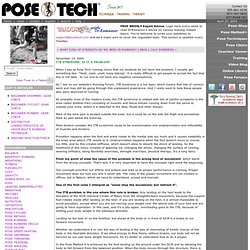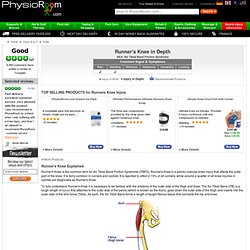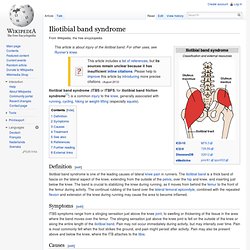

ITB SYNDROME, IS IT A PROBLEM? - Training With Dr.Romanov. When I say at Pose Tech running clinics that my students do not have this problem, I usually get something like: "Yeah, yeah, yeah, keep talking".

It is really difficult to get people to accept the fact that this is not fatal - to run and to not have any negative consequences. As I see on our website's Running Forum, ITB syndrome is a hot topic, which means that lots of runners went and may still be going through this unpleasant experience. And I really want to help these people who were deprived of running.
As probably most of the readers know, the ITB syndrome is related with lots of painful symptoms in the area called iliotibial tract consisting of muscles and fascia tissues running down from the pelvis to outside your knee, where it is attached to the tibia, fibula and other tissues. Not a muscle, so stretching irreland, but massage via roller s good. Runners Knee Injury. Runner's Knee Explained Runner's Knee is the common term for Ilio Tibial Band Friction Syndrome (ITBFS).

Runner's Knee is a painful overuse knee injury that affects the outer part of the knee. It is fairly common in runners and cyclists. It is reported to affect 2-10% of all runners, while around a quarter of all knee injuries in cyclists are diagnosed as Runner's Knee. To fully understand Runner's Knee it is necessary to be familiar with the anatomy of the outer side of the thigh and knee. The Lateral Epicondyle is a bony prominence that is the widest point of the thigh bone. During activities such as running and cycling, where there is repeated bending and straightening of the knee joint, the ITB can 'impinge' upon the Lateral Epicondyle and the resultant friction can lead to inflammation of the tissues. Between the ITB and the thigh there is a sac of fluid, called a bursa, which is meant to prevent friction. Runner's Knee Signs & Symptoms. Wits Abstract. ITB. Iliotibial band syndrome. Definition[edit] Symptoms[edit] ITBS symptoms range from a stinging sensation just above the knee joint, to swelling or thickening of the tissue in the area where the band moves over the femur.

The stinging sensation just above the knee joint is felt on the outside of the knee or along the entire length of the iliotibial band. Pain may not occur immediately during activity, but may intensify over time. Pain is most commonly felt when the foot strikes the ground, and pain might persist after activity. Causes[edit] ITBS can result from one or more of the following: training habits, anatomical abnormalities, or muscular imbalances: Training habits: Abnormalities in leg/feet anatomy: High or low archesSupination of the footExcessive lower leg rotation due to over-pronationExcessive foot strike forceUneven leg lengthBowlegs or tightness about the iliotibial band.
Muscle imbalance: Treatment[edit] See also[edit] References[edit] Further reading[edit] Martens M, Libbrecht P, Burssens A (1989). What Is the IT Band or ITB and Why Does it Cause Me Pain. Many a runner has been sidelined by knee pain caused by the iliotibial band (aka the ITB).

But knowing how to deal with this long band of fascia, which runs down the outside of the thigh from the pelvis to just below the shin, can help keep an injury at bay. Knowledge is power, and we want to help keep you on the road. First off, fascia is a stiff connective tissue (like tendons and ligaments) that surrounds muscles, bones, and joints, providing both support and protection. It's like shrink-wrap; once fascia becomes tight it tends to stay tight, causing pain and injuries. When the ITB shortens, usually due to poor biomechanics (like losing your running technique when tired), it can pull the kneecap out of alignment. To avoid overuse injuries, it's important to keep this thick band of fascia flexible, especially if you're training for a race and upping your weekly mileage.
We recommend a combination of foam rolling and stretching when the body is warm from exercise. Roll out Stretch It! Running Injuries - ITB.